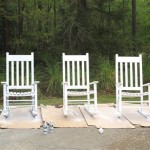Outdoor Seating Area Dimensions: A Comprehensive Guide
Creating a functional and inviting outdoor seating area requires careful consideration of dimensions. The dimensions must accommodate the intended use, the number of occupants, and the overall aesthetic of the space. Neglecting proper planning can lead to an uncomfortably cramped zone, or a space that feels sparsely populated and lacks intimacy. This article provides a comprehensive guide to understanding and planning outdoor seating area dimensions, covering key aspects such as furniture spacing, pathways, and considerations for various types of seating configurations.
Understanding Clearance and Circulation
One of the most crucial aspects of planning outdoor seating area dimensions is understanding the need for adequate clearance and circulation. This dictates how comfortably individuals can move around the space, sit, and stand without feeling restricted or bumping into furniture and other occupants. Minimum clearance distances should be established based on the activities planned for the area. For pathways, a minimum width of 36 inches (91 cm) is generally recommended to allow one person to pass comfortably. If the pathway is intended for two people to walk side-by-side, a width of 48 inches (122 cm) or more is preferable.
Around seating areas, a minimum of 18 inches (46 cm) of clearance should be provided between the edge of the seating and any obstacles, such as walls, planters, or other furniture. This allows individuals to easily maneuver around the seating. For dining areas, consider the space needed to pull out chairs. A minimum of 30 inches (76 cm) should be provided between the edge of the table and any obstacles to allow comfortable chair movement. If the space also functions as a high-traffic area, these clearance distances should be increased to accommodate movement.
The placement of doors and windows also impacts circulation. Ensure that seating arrangements do not obstruct access to these openings. Leave sufficient space for doors to swing open without hitting furniture or impeding movement. Similarly, consider window placement and whether individuals will be walking or sitting in front of them. Avoid blocking natural light or creating awkward situations with seating too close to window openings.
In addition to physical dimensions, consider the visual impact of space. Crowding furniture together can make an area feel smaller than it is. Conversely, excessively large spaces can feel impersonal and less inviting. Careful planning ensures a balanced and proportionate design.
Key Considerations for Different Seating Configurations
The dimensions of an outdoor seating area are heavily influenced by the type of seating configuration chosen. Different seating arrangements require varying amounts of space to function effectively. Understanding the specific space requirements for each type of arrangement is essential for accurate planning.
Dining Areas: Dining areas require the most space per person due to the table and chairs. A good rule of thumb is to allow at least 24 inches (61 cm) of space per person around the table. For a rectangular table intended to seat six people, the table itself should be at least 6 feet (183 cm) long and 3 feet (91 cm) wide. To accommodate chair movement and circulation, the overall space around the table should be at least 10 feet by 7 feet (305 cm x 213 cm). For round tables, the diameter should be at least 4 feet (122 cm) for four people and 5 feet (152 cm) for six people. The surrounding space should be at least 9 feet (274 cm) in diameter to accommodate chair movement.
Lounge Areas: Lounge areas, typically featuring sofas, chairs, and coffee tables, require slightly less space than dining areas. A typical sofa is approximately 7-8 feet (213-244 cm) long and 3 feet (91 cm) deep. Allow at least 3 feet (91 cm) of space between the sofa and any coffee table. Chairs typically require a footprint of 3 feet by 3 feet (91 cm x 91 cm). Arrange chairs to encourage conversation, leaving approximately 6-8 feet (183-244 cm) between seating areas for comfortable interaction. Overall, a lounge area designed for four people would require a minimum of 10 feet by 12 feet (305 cm x 366 cm) to feel spacious and comfortable.
Conversation Areas: Conversation areas, often centered around a fire pit, require careful consideration of safety and circulation. A fire pit should be at least 3 feet (91 cm) in diameter and surrounded by seating at a safe distance. A minimum of 7 feet (213 cm) of clearance should be maintained between the fire pit and any combustible materials, such as overhanging branches or wooden structures. Seating arrangements should allow all occupants to comfortably face the fire pit. Individual chairs or benches arranged in a circle around the fire pit are common configurations. Ensure that each seating position has ample space for movement and that pathways leading to and from the area are clear and well-lit. A conversation area designed for 6-8 people typically requires a space of at least 15 feet by 15 feet (457 cm x 457 cm).
Bar Areas: Outdoor bar areas require space for bar stools, the bar itself, and circulation behind the bar. Bar stools typically require a footprint of 2 feet by 2 feet (61 cm x 61 cm) each. Allow at least 2 feet (61 cm) of space between bar stools to prevent crowding. The bar itself should be at least 2 feet (61 cm) deep and long enough to accommodate the desired number of guests. A minimum of 3 feet (91 cm) of space should be provided behind the bar for comfortable movement and operation. A bar area designed for four people typically requires a space of at least 8 feet by 10 feet (244 cm x 305 cm).
When planning any seating area, consider the placement of accessories such as side tables, planters, and lighting fixtures. These elements contribute to the overall ambiance and functionality of the space, but they also require additional space. Ensure that these accessories are positioned in a way that enhances the usability of the area without creating obstacles or hazards.
Adapting Dimensions to Available Space and Site Conditions
While general guidelines for outdoor seating area dimensions are helpful, it is essential to adapt these recommendations to the specific constraints and opportunities of the site. Not all outdoor spaces are perfectly square or rectangular, and existing features such as trees, slopes, and structures can significantly impact the layout and dimensions of the seating area.
Small Spaces: In small spaces, maximizing functionality is critical. Opt for multifunctional furniture such as benches with built-in storage or folding tables that can be easily stored away when not in use. Consider vertical solutions such as wall-mounted planters or trellises to add greenery without taking up valuable floor space. Use space-saving seating arrangements such as bistro sets or small loveseats. Avoid overcrowding the space with too much furniture. Focus on a few key pieces that provide comfortable seating without overwhelming the area. Using lighter colors and reflective surfaces can also help to make a small space feel larger and more open.
Uneven Terrain: Sloping or uneven terrain can pose challenges for creating a comfortable and functional seating area. Consider using retaining walls or terraces to create level surfaces for seating. Alternatively, choose furniture that is designed to accommodate uneven surfaces, such as adjustable chairs or tables. Ensure that all surfaces are stable and secure to prevent accidents. Properly addressing uneven terrain will not only improve the usability of the seating area but also enhance its overall aesthetic appeal.
Existing Features: Incorporate existing features such as trees, rocks, and water features into the design of the seating area. Trees can provide shade and privacy, while rocks and water features can add visual interest and create a relaxing atmosphere. Plan the seating arrangement around these features to maximize their benefits. For example, position seating under a tree to take advantage of the shade, or create a seating area overlooking a water feature. Be mindful of the potential impact of these features on the seating area, such as falling leaves or splashing water. Protect furniture and surfaces as needed to prevent damage.
Climate Considerations: Climate conditions can also influence the dimensions and layout of an outdoor seating area. In hot climates, consider providing shade through the use of pergolas, umbrellas, or awnings. Position seating in areas that receive adequate shade during the hottest parts of the day. In windy areas, consider using windbreaks such as screens or hedges to protect the seating area from the elements. In cold climates, consider incorporating heating elements such as fire pits or outdoor heaters to extend the usability of the seating area during cooler months. The choice of materials should also be influenced by climate conditions. Durable, weather-resistant materials such as teak, aluminum, and synthetic wicker are ideal for outdoor furniture.
In addition to these considerations, always comply with local building codes and regulations when planning an outdoor seating area. Building codes may specify minimum setbacks from property lines, maximum height restrictions, and other requirements that can impact the dimensions and layout of the area. Obtain any necessary permits before beginning construction to avoid potential fines or delays.

How To Choose The Perfect Size Patio Planning Your Part I Trunorth Landscaping

A Designer S Guide To Creating Your Dream Outdoor Space

How To Choose The Perfect Size Patio Planning Your Part I Trunorth Landscaping

The Big Benefits Of Small Space Furniture Home Style

Outdoor Seating Requirements For Food Service Industry The St Bernard News

A Designer S Guide To Creating Your Dream Outdoor Space

Diy Outdoor Bench Design Home Tutorials

Complete Guide To Patio Tables Bonus Styling Tips

Patio Furniture Space Plan Interior Design Tips Planning Layout

Key Measurements For Designing Your Perfect Patio








